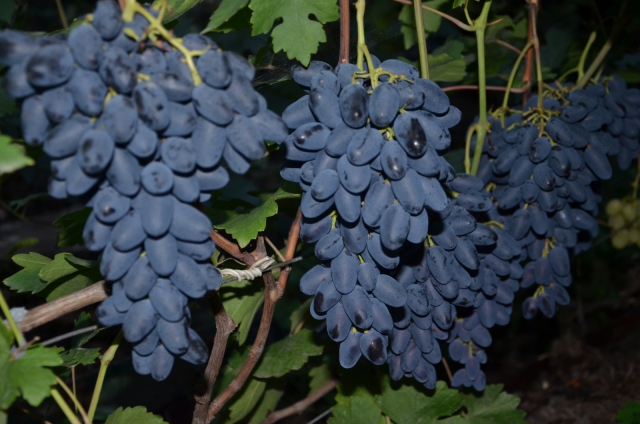
Not so long ago, Crimean breeders wondered whether it is possible to grow such a variety of grapes so that it produces high-quality fruits and is frost-resistant. And such a culture was bred. This is “In memory of Dzheneyev”, or, as it is also called, “Academician Avidzb”.
Content
Grade Features
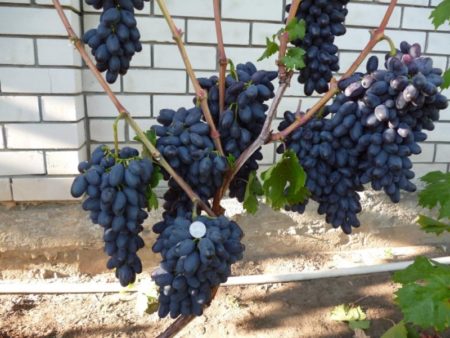
Grapes “In memory of Dzheneev” was bred when crossing varieties “Gift Zaporozhye” and “Richelieu”. The hybrid grows well and bears fruit both in the South and in the middle zone of Russia. Able to tolerate frosts to minus 30 degrees.
Refers to early ripe crops. The fruits ripen in August, 115 days after the moment of vegetation. Despite the fact that the variety is very young, it is grown by industrial plantations. Included in the blends of the best red wines.
"In memory of Dzheneyev" refers to table black grapes. Mostly grown for wine. But in private estates, grapes are also eaten fresh. It is worth noting that the berries are completely seedless.
The harvest is well preserved. Berries withstand long-distance transportation. Growing grapes is a cost-effective business, as the fruits are distinguished by their unsurpassed taste.
Akademika Avidzba is a very young variety. Therefore, its resistance to insect pests and certain diseases has not yet been fully studied. However, it is known that gray rot is the scourge of culture. She can ruin the entire crop on the vine.
Culture characteristics
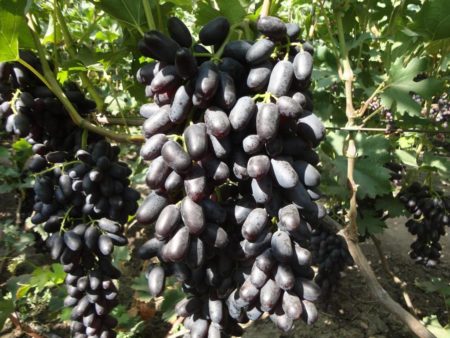
The vine "Akademika Avidzba" is fast-growing. It has a dark green hue. The leaves grow medium and large. Five-armed, carved, with visible veins. They have an intense green tint. Their outer side is smooth, a rare fluff grows on the inside.
Bisexual flowers that do not require additional pollination. Berries are large, grow up to 33 mm in length and 20 mm in width. They have a dark blue color. Top covered with whitish bloom. Elongated in shape with a blunt rounded end.
The pulp is yellow, dense, crisp. The taste is sweet with a fine acidity, resembling a ripened cherry; chocolate aftertaste. The quality of the fruits on a ten-point scale has a rating of 9.8 points. Sugar content of berries is high.
The peel of the fruit is dense, does not burst with high humidity. Bunches - medium density, cone-shaped. Very big. When ripening, they gain weight up to 1.8 kg.
Advantages and disadvantages of grapes
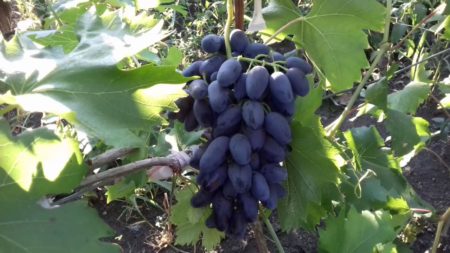
The variety consists mainly of one virtue. When growing shows:
- high productivity;
- endurance;
- frost resistance;
- excellent taste;
- early ripening;
- good keeping quality;
- ability to transport.
The only disadvantage of the culture is low resistance to fungal diseases. If you do not conduct timely preventive maintenance of bushes, the crop may rot even before it is harvested.
Diseases and Pests
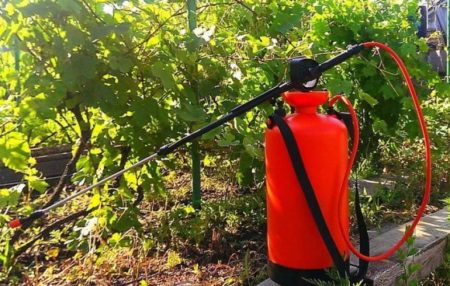
The plant is resistant to many diseases. But it shows weakness before powdery mildew and gray rot. It is necessary to constantly carry out preventive measures against these misfortunes. Otherwise, the crop will simply rot on the bushes.
Copper sulfate is suitable for the procedures. Prepare an aqueous solution with this drug and periodically pollinate the bushes.
Culture is resistant to various pests, including slugs. But it is very interesting for wasps and birds. They can cause significant damage to crop yields.
It is not difficult to protect the Academician from birds. It is enough to put a mesh fence around the vineyard. Mesh pouches become salvation from wasps. They are tied up on each bunch. The bags let in enough sunlight and do not interfere with the ripening of the crop.
Agricultural technology varieties
“In memory of Dzheneyev” is attractive for growing in a summer cottage, as it does not require much care. And yet, basic agricultural activities are necessary.
Choosing a landing place
Grapes propagated by cuttings. Before planting, you must choose a place to land. Certain requirements are imposed on him:
- rationing of sunlight;
- protection from strong northerly winds;
- soil fertility.
Like all grape crops, the variety loves the sun. It grows well at a temperature of 25-30 degrees. However, it is grown in the South, where temperatures in the summer reach 40 degrees. In this case, slightly shaded should choose a place to land.
In the middle zone of Russia, cozy temperature indicators. However, northern winds are raging. Therefore, planting is best placed in protected places where the temperature is kept higher. For arranging a vineyard fit: a place near the fence, behind the wall of a house or a barn.
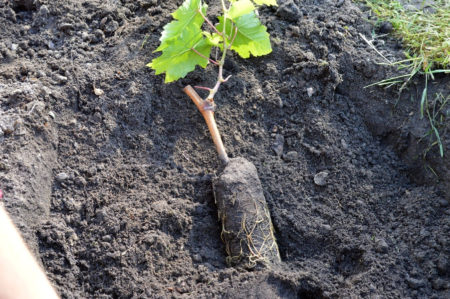
Culture loves well-loosened, fertile soil. Therefore, it is recommended to prepare the necessary soil composition in the fall. Organic matter is laid in the soil: rotted manure, compost. Additionally, fertilizers are applied when planting plants.
Landing choose a bed and trench. If the vineyard is arranged on clay soil in a region where there are little snowy winters, it is recommended to plant in trenches. On other soils, bed planting is preferred.
Landing
Plant "Memory of Dzheneyev" in pre-prepared pits. Their diameter should be at least 60 cm, height - 80 cm. Depending on the characteristics of the soil, the bottom of the pit is arranged. If the soil is sandy, clay is mixed into it. Then the pit will retain moisture. If the soil is alumina, install drainage. For him, a small stone is poured at the bottom of the pits, and on top is a layer of sand.
Next, a layer of fertile soil is placed in the pit. To do this, previously excavated earth is mixed with organic and mineral fertilizers. Pour soil in layers. After placing the first layer, a bucket of water is poured into the pits. Then pour the second layer. Dense soil will allow the roots to hold firmly. After laying the fertile cover, the pits are left to stand for a month.
When planting, cuttings are set in the center of the pits. They fall asleep with light fertile soil and mulch the soil at the roots. Any material is suitable for mulch: dry straw, dried moss, mowed grass, onion peel.
Watering
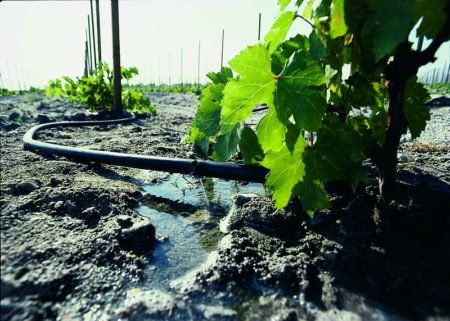
Since “Akademika Avidzba” is a table variety, it must be watered constantly. The first watering is carried out in the spring after the opening of the grapes and garter of its shoots on the trellis. Up to 4 buckets of water mixed with wood ash must be poured under the roots. The second watering is before flowering.
During flowering, watering is not recommended. Bushes can lose the bulk of the flowers and not give the desired crop. The remaining berries have a tendency to pea. The next watering is carried out after flowering.
When the berries get color, watering is stopped. If you water the vineyard further, the berries will grow watery and will not gain enough sweetness. The last watering is carried out in autumn, after harvesting and before sheltering the vines.
Feeding
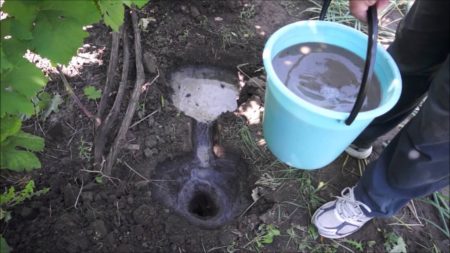
The plant is well fed. Basal top dressing is done in such periods:
- after removal of the shelter (an aqueous solution of manure is introduced into the soil);
- two weeks before flowering (the same fertilizer);
- before the ripening of the fruits (fed with superphosphates and potassium salt);
- after harvest (make potash fertilizers).
Every three years, under digging, a mixture of fertilizers is added to the soil: manure, ash, superphosphate, ammonium sulfate. If the soil is sandy loam fertilizer is applied every two years, if sandy - annually.
Culture perceives foliar top dressing well. Complex mineral fertilizers are particularly suitable. They are brought in as follows:
- before flowering;
- during flowering;
- during the ripening of berries.
Trimming and shaping bushes
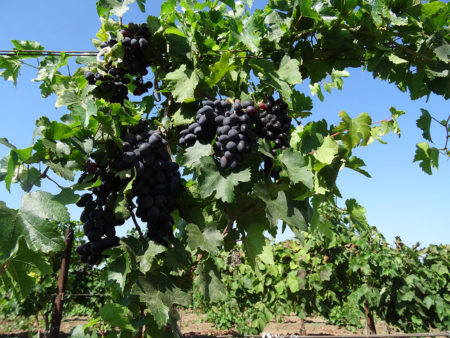
Pruning is carried out twice a year: in early spring before sap flow and in late autumn before sheltering. In the spring, the coots inspect, remove frozen and weak shoots. Immature and weak shoots are removed in the fall. The procedure is carried out at zero temperature.
Throughout the period of growth, flowering and ripening of the berries, bushes are formed. All summer the extra stepsons are removed. When the berries reach the size of a pea, thin out the green mass of the leaves. No more than five leaves are left over the bunches. The rest is removed.
To give berries more nutrition, remove leaves and shoots in the lower tiers of the bushes. Conduct a normalization: remove all clusters, with the exception of two or three. They will give a good harvest in the fall.
Chasing is carried out, leaving 14-15 leaves on each shoot. Pinch the ends of the shoots. This procedure must be carried out so that the green mass of the bushes does not increase. Otherwise, the greens will clog the clusters and the berries will begin to peel.
To strengthen the roots of an adult plant and ensure their deep rooting, surface roots are trimmed. To do this, choose roots that are 20 cm at ground level. Using a pruner they are removed.
Shelter for the winter
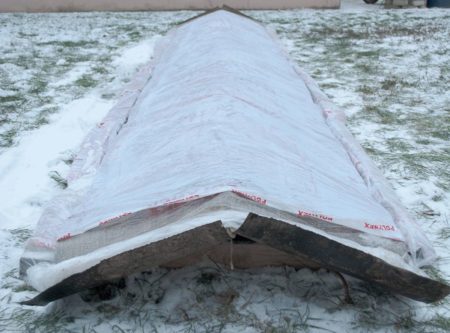
Although the culture is frost-resistant, it requires shelter. In the southern regions, where winter temperatures do not exceed minus 15 degrees, it is enough to lay the vines on the ground and sprinkle with soil. In colder climates, shelter should be more thorough.
In frosts of minus 25 degrees, it is recommended that the vines be wrapped in non-woven material. Spandbond is great for this purpose. It not only protects against frost, it also does not allow moisture to pass through. Plants are covered with material in several layers, and then sprinkled with earth or peat.
At winter temperatures of minus 30 degrees, it is desirable to form a reliable shelter. To do this, the vines are bundled and covered with non-woven material. Arches are formed from above, which are covered with cellophane.
Reviews of amateur winegrowers
Victor, 42 years old
I have a lot of new varieties on the site. I love the news. The year before last, my brother gave the handle of "Academician Avidzb". In two years, a large beautiful bush has grown. This year was the first crop. The whole family liked the berries. They have a very unusual sweet taste with a musky-chocolate finish. I want to plant a few more cuttings next year.
Anna, 46 years old
Very fond of growing grapes. When I was presented with the escape of Academician Avidzb, I was very glad. In the first year after planting, the stalk diligently harbored. In the second year, she left two sleeves. The plant has grown powerful. Thinned out several times. Presented this year with the first harvest.The berries turned out to be a very unusual pleasant taste. In my garden, varieties have become one of my favorites.
Anatoly, 62 years old
I want to talk about the variety "In memory of Dzheneyev." In the second year of life, the bush grows large. Gives about 12 clusters. The clusters are moderately dense, conical. Berries from moisture do not crack (although this summer was cool and rainy). The pulp is dense, crisp. The taste is very pleasant, sweet.
Nadezhda, 53 years old
I really like “In Memory of Dzheneyev”. The variety is early ripe. In my area, the crop has ripened on August 20. The clusters freaked out at 1.6 kg. The berries are large oval, seedless. The taste is inimitable - sweet with nutmeg sourness and chocolate aftertaste. The application is universal. I make grapes jam and wine.
According to amateur winegrowers who cultivate grapes, “In memory of Dzheneyev” (aka “Academician Avidzb”) does not require particularly careful care. The harvest is rich. Berries have an unusual pleasant taste.




 Non-covering winter-hardy grape varieties for Moscow region
Non-covering winter-hardy grape varieties for Moscow region How to keep the vine in winter
How to keep the vine in winter When can I transfer grapes to another place in the fall
When can I transfer grapes to another place in the fall How to cover and prepare grapes for the winter in the suburbs
How to cover and prepare grapes for the winter in the suburbs
Evgeniy
Some winegrowers to increase the frost and winter hardiness and establish a permanent box, as for warm beds with a width of the size of the film sleeve and a half meters, three meters long, or whatever is convenient for you. The vine is laid and pinned to the soil, covered with a dense spanbond. On top of it, film mats are laid according to the size of the box with an insulated “isospan” insulation material at least five centimeters thick. The aisles between the boxes are additionally covered with hay or straw, because during winters with little snow, the main thing is sheltering the root system, and the vines are secondary. In spring, at stable positive temperatures, the mats are cleaned under a canopy to preserve the film, and the spanbond is left in the boxes until the buds open, which increases the growing season and, as a result, early ripening of berries and ripening of the vine. To quickly warm the soil after snow has melted, hay is removed from the aisles and also stored for use in the fall.